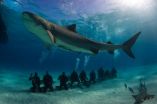(Press-News.org) URBANA – When faced with a choice between a deluge or a controlled deluge in May 2011 that would protect the city of Cairo, Illinois, the U.S. Army Corps of Engineers chose the latter by ordering an intentional breach of the Mississippi River levee at Bird's Point, but was it the right decision?
"The decision was a difficult and complex engineering problem with significant social and political trade-offs between loss of human lives and loss of properties in urban and rural areas," said University of Illinois researcher Ken Olson. "But it was a calculated risk built on a growing body of river science and prior flooding experiences."
Olson explained that the city of Cairo occupies a small sliver of land about 2 square miles or 1,300 acres in size, which is only 1 percent of the size of the New Madrid Floodway (210 square miles or 133,000 acres).
"Due to the size of Cairo and lack of an outlet, even if the sea wall or the earthen levee system which protects Cairo had failed, the filling of the city with floodwater would have done little to drop the record Cairo gauge peak of 61.72 feet on May 3, 2011, and threats to downstream levees would have continued to be a high concern," Olson said.
According to Olson's study, the greatest danger to levee failure is constant water pressure against the levee. The weight of the river pushes water underneath the levee, creating boils and undermining the strength of the levee and its capacity to hold water. Consequently, allowing the levee to break on its own would have created much more damage.
"Cairo levee failure was a real possibility because there was a serious sand boil situation on the earthen levee which was apparently part of the reason the Corps of Engineers rushed to open the floodway on May 2nd," Olson said. By the end of April, the floodwaters on the levee and seawall at Cairo, Illinois, had reached 18.6 meters (61 ft) and were rising. "Floodwaters were starting to put significant pressure on the Cairo seawall and levee system with some seepage or sand boils," he said.
In Olson's opinion, the failure of the seawall and levee system would have covered the City of Cairo with 22 feet of floodwater for days and could have resulted in significant loss of life and severe damage to more than 600 buildings in the cities of Cairo, Future City, and Urbandale, Illinois.
"Given that scenario, any Illinois citizens who failed to follow evacuation orders issued on May 1 would have been in serious trouble, and the Cairo levee or seawall breech could have resulted in the loss of life as well as significant damage to city infrastructure and buildings," he said.
Olson's study states that the Future City area has the capacity to provide an additional 3,000 acres of unintended floodwater storage and an additional 30,000 to 45,000 acre-feet of floodwater storage if the Cache River levee break had occurred.
"This area, which is at a slightly higher elevation, could store water to a 10- to 15-foot depth, depending on the location, and also includes levee-protected Illinois farmland," Olson said. "Ultimately, the Illinois agricultural land inside the Cairo seawall and levee system was protected from flooding, and there was no crop loss or soil damage. The Illinois cropland outside the levee was flooded before the 2011 crop was planted, and the water dropped sufficiently by June 10, 2011, to permit the planting of soybeans."
"The effects of 2011 Ohio and Mississippi river valley flooding on Cairo, Illinois, area," co-authored by Lois Wright Morton, was published in the March/April 2012 issue of the Journal of Soil and Water Conservation.
INFORMATION:
Effects of flooding on Cairo, Ill.
2012-03-12
ELSE PRESS RELEASES FROM THIS DATE:
7-country study examining the causes of childhood pneumonia outlined
2012-03-12
(BALTIMORE, MD.) – The scientific journal Clinical Infectious Diseases has released its March Special Supplement focusing entirely on the research design of and pilot data from the Pneumonia Etiology Research for Child Health (PERCH) Project, which seeks to identify the causes of pneumonia among the world's most vulnerable populations. PERCH, led by the International Vaccine Access Center (IVAC) at the Johns Hopkins Bloomberg School of Public Health in collaboration with 7 research centers worldwide, is the largest and most comprehensive study of the etiology of childhood ...
Sport fields: Catalysts for physical activity in the neighborhood?
2012-03-12
If you're a woman, older adult, or have higher levels of education, you're less likely to be sufficiently physically active. Those are some of the findings of a new University of Alberta study examining people's actual and perceived access to sport fields as catalysts for physical activity.
"We know there are many studies indicating that the actual or perceived access to facilities is associated with physical activity, but it is not clear whether the perceived environment or objective environment exert stronger influences on physical activity," says study author Nicoleta ...
Nanotube technology leading to new era of fast, lower-cost medical diagnostics
2012-03-12
CORVALLIS, Ore. – Researchers at Oregon State University have tapped into the extraordinary power of carbon "nanotubes" to increase the speed of biological sensors, a technology that might one day allow a doctor to routinely perform lab tests in minutes, speeding diagnosis and treatment while reducing costs.
The new findings have almost tripled the speed of prototype nano-biosensors, and should find applications not only in medicine but in toxicology, environmental monitoring, new drug development and other fields.
The research was just reported in Lab on a Chip, a ...
An insight into human evolution from the gorilla genome sequence
2012-03-12
Researchers announce today that they have completed the genome sequence for the gorilla, the last genus of the living great apes to have its genome decoded. While confirming that mankind's closest relative is the chimpanzee, the team shows that much of the human genome more closely resembles the gorilla than it does the chimpanzee genome. This is the first time scientists have been able to compare the genomes of all four living great apes: humans, chimpanzees, gorillas and orangutans. This study provides a unique perspective on human origins and is an important resource ...
Brain cancer blood vessels not substantially tumor-derived, Johns Hopkins scientists report
2012-03-12
Johns Hopkins scientists have published laboratory data refuting studies that suggest blood vessels that form within brain cancers are largely made up of cancer cells. The theory of cancer-based blood vessels calls into question the use and value of anticancer drugs that target these blood vessels, including bevacizumab (Avastin).
"We don't question whether brain cancer cells have the potential to express blood vessel markers and may occasionally find their way into blood vessels, but we do question the extent to which this happens," says Charles Eberhart, M.D., Ph.D., ...
Evidence-based systems needed to reduce unnecessary imaging tests
2012-03-12
Philadelphia, PA, March 9, 2012 – Imaging has been identified as one of the key drivers of increased healthcare costs. A new study from Brigham and Women's Hospital and Harvard Medical School has found significant variation in the use of head computed tomography (CT), even within a single emergency department. Strategies to reduce such variation in head CT use may reduce cost and improve quality of care. The study appears online in advance of publication in the April issue of The American Journal of Medicine.
A recent measure approved by the Centers for Medicare and ...
Global warming threat to coral reefs: Can some species adapt?
2012-03-12
Coral reefs are among the ecosystems most severely threatened by global warming, but hopeful new evidence has emerged that some coral species may be able to adapt to warmer oceans.
In a study published in the journal PLoS One, an international team of researchers reports that coral populations which unexpectedly survived a massive bleaching event in 2010 in South-East Asian waters had previously experienced severe bleaching during an event in 1998.
The team analysed what happened at three sites during the 2010 event and found that in Indonesia, corals responded to higher ...
Strengthening the bond between policy and science
2012-03-12
One only has to be reminded of the BSE crisis and the MMR vaccine scare to recognise the importance of having policy informed by the best available science. Now, a collaboration of over fifty academics and policy makers from around the world have come together to agree a new research agenda on the role of science in public policy. The findings appear today Friday, 09 March in PLoS ONE, a leading interdisciplinary open-access journal.
The importance of using science for public policy has long been recognised, but recent years have seen a growing debate over how this is ...
Bite the hand that feeds...
2012-03-12
LONDON – (March 8, 2012) -- Ecotourism activities that use food to attract and concentrate wildlife for viewing have become a controversial topic in ecological studies. This debate is best exemplified by the shark dive tourism industry, a highly lucrative and booming global market. Use of chum or food to attract big sharks to areas where divers can view the dwindling populations of these animals has generated significant criticism because of the potential for ecological and behavioral impacts to the species. However, the debate has been largely rhetorical due to a lack ...
Literal Lucy to the rescue: A new way to distinguish between literal meaning and contextual meaning
2012-03-12
Washington, DC – A new linguistic study of how individuals interpret various types of utterances sheds more light on how literal and contextual meaning are distinguished. The study, "A novel empirical paradigm for distinguishing between What is Said and What is Implicated," to be published in the March 2012 issue of the scholarly journal Language, is authored by Ryan Doran, Gregory Ward, Meredith Larson, Yaron McNabb, and Rachel E. Baker, a team of linguists based at Northwestern University. A preprint version is available online at:
http://lsadc.org/info/documents/2012/press-releases/doran-et-al.pdf
Within ...


